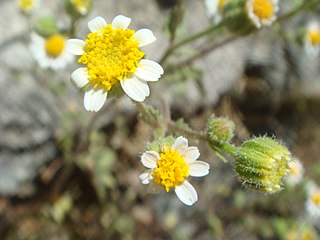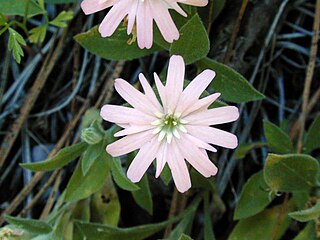
Sphaeralcea is a genus of flowering plants in the mallow family (Malvaceae). There are about 40-60 species, including annuals, perennials, and shrubs. Most originate in the drier regions of North America, with some known from South America. They are commonly known as globemallows, globe mallows, false mallows or falsemallows. The name of the genus is derived from the Greek words σφαῖρα (sphaira), meaning "sphere," and αλκεα (alkea), meaning "mallow."

Phacelia campanularia is a species of flowering plant in the borage family, Boraginaceae, known by the common names desertbells, desert bluebells, California-bluebell, desert scorpionweed, and desert Canterbury bells. Its true native range is within the borders of California, in the Mojave and Sonoran Deserts, but it is commonly cultivated as an ornamental plant and it can be found growing elsewhere as an introduced species.

Platystemon is a monotypic genus of flowering plants in the poppy family containing the single species Platystemon californicus, which is known by the common name creamcups. It is native to Oregon, California, Arizona, Utah and Baja California, and is found in open grasslands and sandy soils below 6,000 feet (1,800 m) elevation.
Sphaeralcea incana, with the common names gray globemallow and soft globemallow, is a desert plant in the mallow family (Malvaceae).

Rosa chinensis, known commonly as the China rose, Chinese rose, or Bengal rose, is a member of the genus Rosa native to Southwest China in Guizhou, Hubei, and Sichuan Provinces. The first publication of Rosa chinensis was in 1768 by Nikolaus Joseph von Jacquin in Observationum Botanicarum, 3, p. 7 & plate 55.

Sphaeralcea laxa, with the common name caliche globemallow, is a desert plant in the mallow family (Malvaceae).

Sphaeralcea ambigua, is a species of flowering plant commonly known as desert globemallow or apricot mallow, is a member of the genus Sphaeralcea in the mallow family (Malvaceae).

Herissantia crispa is a species of flowering plant in the mallow family known by the common names bladdermallow and curly abutilon. It is native to the tropical Americas but it can be found throughout the tropical and warmer temperate world as an introduced species and sometimes a weed. This is a perennial or sometimes annual herb growing up to about 1.5 meters in maximum stem length, usually taking a trailing or creeping form. It is coated in whitish hairs. The oval or heart-shaped leaves are up to 7 centimeters long with rippled edges. The inflorescence is a solitary flower emerging from a leaf axil, borne on a long-haired pedicel which is half erect and then jointed downward. The flower has five pale yellow oval petals each up to a centimeter long. The fruit is a lantern-like inflated sphere ribbed into segments. It is up to 2 centimeters wide, coated in long hairs, and dehiscent, each segment containing 2 or 3 black kidney-shaped seeds.

Sphaeralcea gierischii, Gierisch's globemallow or Gierisch mallow, is an endangered species of flowering plant in the mallow family, Malvaceae. It is native to the western United States, where it is known only from Utah and Arizona. It was described in 2002.

Perityle emoryi is a species of flowering plant in the aster family known by the common name Emory's rockdaisy. It is native to the Southwestern United States, northwest Mexico, and the Baja California Peninsula. It is a common wildflower of the deserts, and can also be found in California coastal regions.

Silene hookeri is a species of flowering plant in the family Caryophyllaceae known by the common names Hooker's silene, Hooker's catchfly, Hooker's Indian pink, and Hooker's glandular campion.

Sphaeralcea angustifolia is a species of flowering plant in the mallow family known by the common names copper globemallow and narrow-leaved globemallow. It is native to the southwestern United States as well as northern and central Mexico, where it grows in desert and plateau habitat. It produces many erect stems, approaching three meters in maximum height. It is woolly or felt-like in texture. The gray-green leaf blades are lance-shaped and measure up to about 5 cm long. They have wavy or slightly lobed edges. The leafy inflorescence bears several flowers each with five wedge-shaped orange petals just under 1 cm in length, and yellow anthers.

Sphaeralcea coulteri is a species of flowering plant in the mallow family known by the common name Coulter's globemallow. It is native to the Sonoran Desert, its distribution extending from northern Mexico north into California and Arizona. It is an annual herb, its slender, hairy stems sprawling or growing erect to a maximum height near 1.5 meters. The thin, gray-green leaf blades are wide and short, heart-shaped or triangular in shape, and measure up to about 5 centimeters long. They have a few wide lobes along the edges which may have teeth or smaller lobes. The leafy inflorescence bears clusters of flowers each with five wedge-shaped orange petals around a centimeter long, and yellow anthers.

Sphaeralcea grossulariifolia is a species of flowering plant in the mallow family known by the common name gooseberryleaf globemallow. It is native to the western United States, where it can be found in the Great Basin and surrounding regions. It grows in sagebrush, woodlands, playas, and the canyons of the upper Colorado River. It is common in disturbed areas, such as habitat recently cleared by wildfire.

Sphaeralcea munroana is a species of flowering plant in the mallow family known by the common names Munro's globemallow and Munro's desert-mallow. It is native to the western United States, where it can be found in the Great Basin and surrounding regions. It grows in sagebrush, desert flats, mountain slopes, and requires plenty of sunlight to thrive. This perennial herb produces erect stems up to about 80 centimetres (31 in) tall from a thick root system. It is woolly and gray-green in color. The alternately arranged leaves have triangular blades up to 6 cm long, usually edged with large lobes and a toothed margin. Flowers occur in clusters on a raceme-like inflorescence. The flower has five apricot to red-orange petals each just over 1 cm long.

Sphaeralcea rusbyi is a species of flowering plant in the mallow family known by the common names Rusby's globemallow and Rusby's desert-mallow. It is native to the southwestern United States, where it can be found in various types of desert habitat. The species is generally divided into three subtaxa which grow in separate sections of the desert southwest. In general, the plant produces hairy or woolly stems which can reach three meters tall. The leaves are lobed or compound. The flowers each have five red-orange petals up to 2 centimeters long.

Streptanthus longisiliquus is a species of flowering plant in the mustard family known by the common name long-fruit jewelflower. It was first described to science in 2007. It is endemic to northern California, where it is known from Butte, Tehama, and Shasta Counties. It can be found in forest and woodland habitat in mountains and foothills. It is a short-lived perennial herb producing a few-branched stem up to 1.2 to 1.5 meters in maximum height. It is mostly hairless except for some light hairs on the inflorescences and sometimes the leaf petioles. The basal leaves have oval or spoon-shaped blades up to 10 centimeters long, usually with smooth edges. Leaves higher on the stem are oval or oblong and lack petioles, their bases often clasping the stem. Flowers occur at intervals along the upper stem. Each flower has a bell-shaped calyx of sepals which yellow-green at the base and purplish at the tip, measuring under a centimeter in length. The petals emerging from the end are brownish or purplish with greenish bases. The fruit is a flattened, curving silique that can be quite long even for the genus, measuring up to 15 centimeters in length.

Ferocactus emoryi, known commonly as Emory's barrel cactus, Coville's barrel cactus and traveler's friend, is a barrel cactus in the genus Ferocactus.
Draba exunguiculata is a species of flowering plant in the family Brassicaceae known by the common names clawless draba and Grays Peak draba. It is endemic to Colorado in the United States.

Oenothera harringtonii is a species of flowering plant in the evening primrose family known by the common names Arkansas Valley evening primrose and Colorado Springs evening primrose. It is endemic to the state of Colorado in the United States.


















